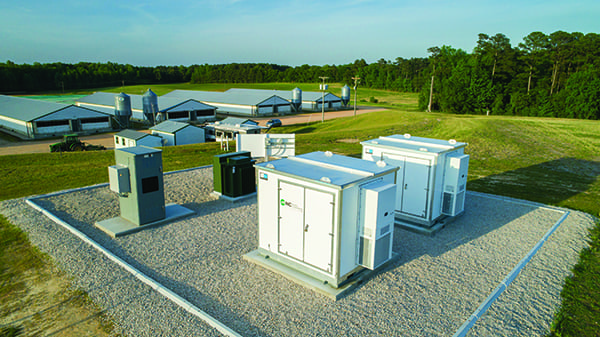The post The POWER Interview: Microgrids Open New Business Models appeared first on POWER Magazine.

Microgrids offer an “all of the above” approach to distributed generation, incorporating a variety of technologies into their design. As microgrids continue to evolve, incorporating renewable power resources, fuel cells, battery energy storage, diesel and gas generator sets, microturbines, and other technologies, they also provide the opportunity to expand the business models for power producers.
Don Wingate, Vice President Utility & Microgrid Solutions at Schneider Electric, recently provided POWER with his insights about the microgrid market. He noted that technology advancements are allowing more rapid deployments, and also “more repeatable and scalable solutions that can fit different applications.”

Wingate talked about the use cases for microgrids, and how decentralized power generation can provide lower energy costs, while also increasing power quality and providing resilience and reliability. He noted the growth in deployment in areas prone to natural disasters, and also as a way for businesses to enhance their bottom lines.
“The watchwords for us are economic advantage, resilience, and sustainability,” he said. “Today, microgrids make a lot of sense for end users with these goals.”
POWER: Are there new technologies being developed that could be deployed in future microgrids? What are some of the latest advances in microgrid control systems?
Wingate: We’re seeing the most advancement come in microgrid controllers —what we think of as the brains of the system. They dictate the use cases and how a microgrid is intended to do its job. Microgrid controls are becoming more configurable, more flexible, and less expensive for customers to deploy.
Additionally, we are now able to deliver pre-packed systems that are configured and tested in a factory setting. All the LV/MV [low voltage/medium voltage] switchgear/breakers/meters/protection devices/controls are assembled, prewired and ready for connection to the distributed resources [photovoltaic, or PV, battery/generator, etc.]. This speeds installation, reduces engineering time, and offers a safe and cost-effective solution for users.
Learn more about microgrids by registering and watching an on-demand presentation of POWER’s recent webcast, “Microgrids—Development and Design,” and plan to attend POWER’s Distributed Energy Conference in October.
POWER: How important is the addition of battery storage to a microgrid’s design?
Wingate: Battery storage is not essential for a microgrid to operate, but in many cases is a great addition. In the simplest scenario many users have solar PV assets and wonder why it will not work in an outage situation. Adding batteries and the appropriate controls provide immediate resilience to a home or commercial building. Because batteries ease the transition from grid power to the ability of the microgrid to island from the grid, they extend the value of the microgrid, shorten the ROI [return on investment]and open up additional use cases for the end user.

POWER: Where are we most likely to see microgrids deployed in the future? Developing nations? Areas prone to natural disasters?
Wingate: In North America, most use cases for microgrids are linked to areas with high electric costs, areas prone to natural disaster, business entities that require high power quality and resilience. and more recently, people and organizations that want sustainable energy.
In developing countries microgrids are really the best tool to provide access to energy. Building large and expensive centralized grids are no longer feasible or technically advantageous. Microgrids are the most promising solutions for developing countries and the most cost-effective solution to provide access to energy.
POWER: Are there particular business sectors, such as agriculture, mining, shipping ports, that are best-suited to use microgrids?
Wingate: While microgrids tend to be segment agnostic, there are certain industries that have been early movers. For us, we have seen data centers, indoor agriculture, electric vehicles, campuses and military applications emerge as segments where microgrids can solve a myriad of challenges and provide immediate value. Large energy users such as ports and mining are also embracing microgrids to improve clean energy goals by incorporating more renewable energy solutions. [Editor’s note: Schneider Electric is involved in a microgrid at the Port of Long Beach in California, a POWER Top Plant award winner in 2019.]
POWER: How important are microgrids to enabling the integration of distributed energy resources such as solar power to the larger grid?
Wingate: One of the most important benefits of microgrids are their ability to add resilience to the grid. When utilities or commercial entities add large grid-scale solar or storage, it helps green the grid, but does not assist with resilience. These grid-scale additions use the same transmission and distribution networks, and nothing changes with energy line loss or outage risk. When microgrids are added behind the meter, resiliency dramatically improves.
Microgrids also offer day-to-day, high-value use cases that provide benefits to the end users. For example, microgrids allow renewable resources to participate in demand charge reduction programs and reduce time-of-use rate penalties. Integration to the grid via microgrids accelerates a more distributed and resilient grid.
POWER: How can microgrids help increase the efficiency of the electric delivery system?
Wingate: Users want some basic functions from the energy supplier: predictable/fair costs, high power quality and consistency of service. The centralized grid was a wonderful achievement when it was designed and built more than 100 years ago, but technology has advanced and the needs of users have evolved. It’s no longer acceptable to have escalating costs and no viability into the future pricing world. Outages are becoming more common with longer duration. Even momentary service interruptions in power quality in our digital world can have devastating effects on industries’ bottom line. For example, I recently spoke with an automotive company that experienced a 2-minute outage that caused all robotics to be shut down and rebooted. This cost them an entire shift. Microgrids provide local control of your energy needs and allow the blending of what is right for the end user with being grid-tied to take what is best from the traditional utility.
POWER: What are the future market prospects for microgrids? Should utilities be involved in developing microgrids as part of their business strategy?
Wingate: Microgrids are projected to grow significantly in both the near-term and long-term. New business models and new players are entering the market. Utilities are exploring adding microgrid capability [non-wires alternatives] to increase resilience on congested circuits, so utilities are already exploring the best use of microgrids in their business strategy.
Yet, looking at the cost and regulatory framework in existence, microgrids tend to favor private ownership. Society needs to consider energy equity in the equation. Rate-basing a microgrid when the primary benefit is for one customer is not currently part of the regulatory model. New business models such as Energy as a Service [EaaS] allow more competition, better value for customers, and better collaboration with traditional grid providers.
—Darrell Proctor is associate editor for POWER (@DarrellProctor1, @POWERmagazine).
The post The POWER Interview: Microgrids Open New Business Models appeared first on POWER Magazine.